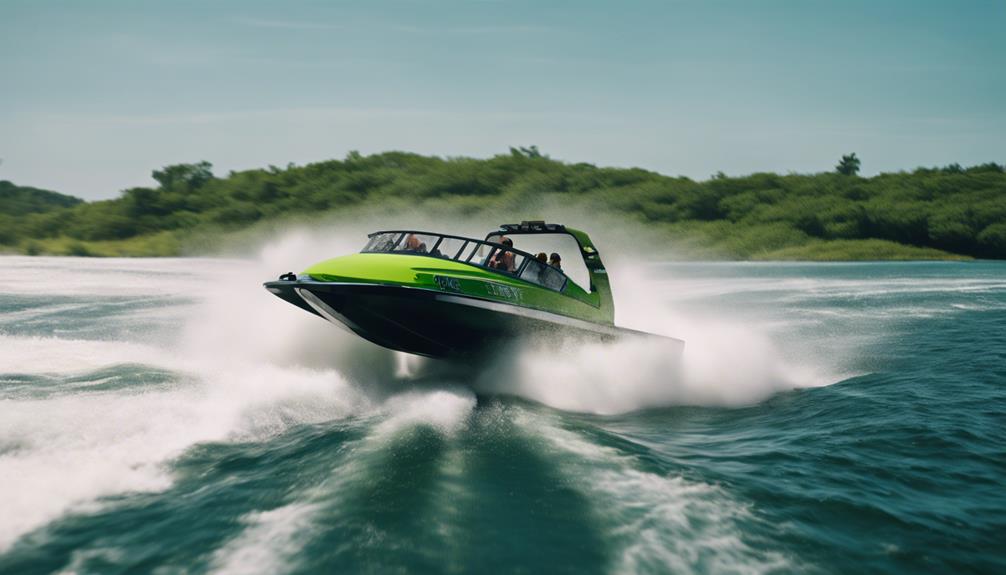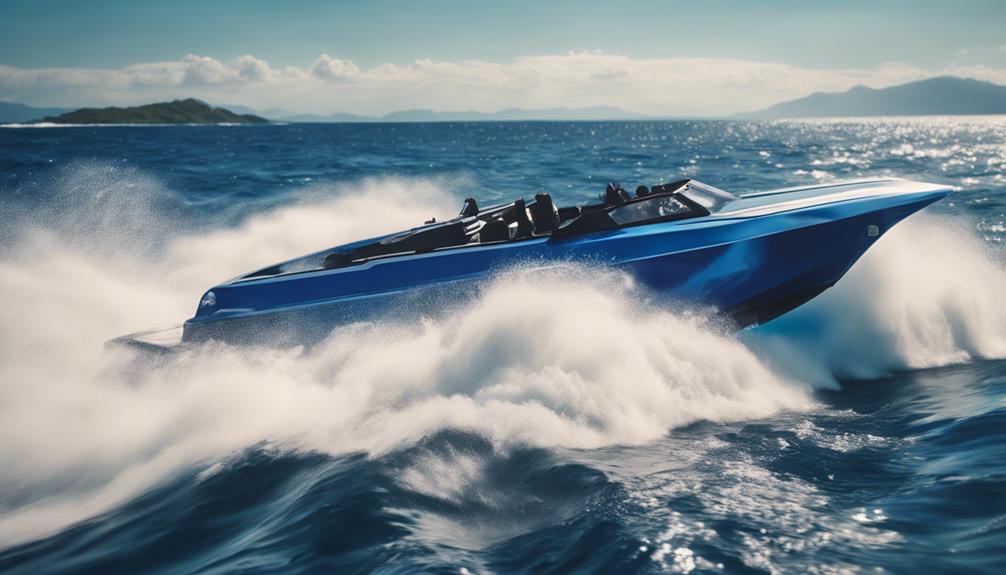To stay safe while jet boating, always wear a life jacket that fits snugly and check weather and water conditions before you go. Follow the manufacturer’s instructions for operation, and keep a safe speed and distance from other vessels. Stay aware of your surroundings, including debris and swimmers, and carry emergency gear like a whistle and phone. Taking a safety course boosts your confidence, and mastering these tips will help you stay prepared for any situation.
Key Takeaways
- Always wear a properly fitted life jacket and carry emergency supplies like a whistle, flashlight, and first aid kit.
- Check weather conditions and water reports before your trip, and postpone if conditions are unsafe.
- Follow manufacturer’s operating instructions, adhere to speed limits, and maintain safe distances from other vessels.
- Take safety training to understand hazard recognition, emergency procedures, and proper boat handling.
- Stay alert to your surroundings, monitor other watercraft, and react quickly to unexpected hazards for safety.
Always Wear a Life Jacket
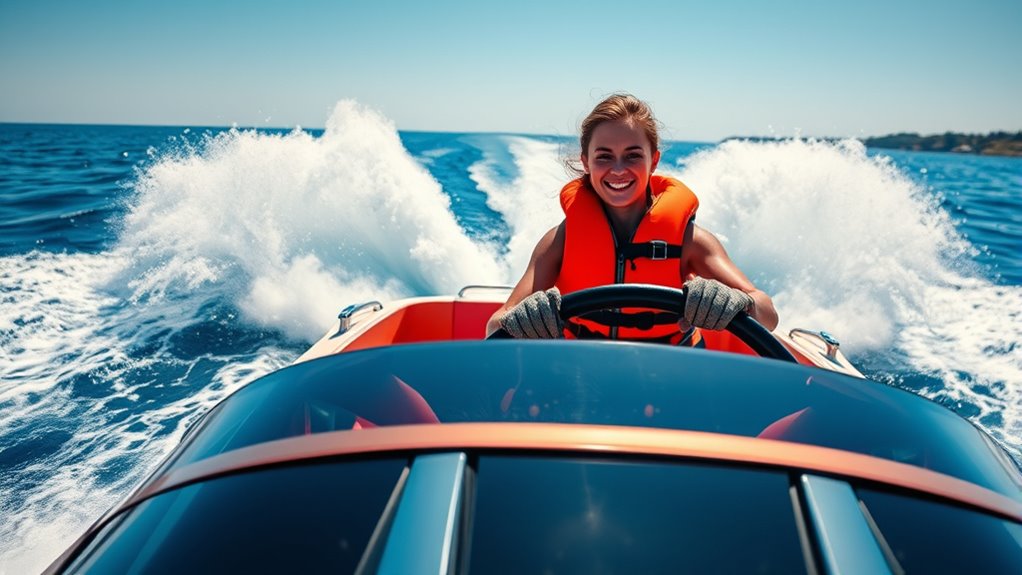
Why take the risk? Wearing a life jacket is your best defense if something goes wrong on the water. Even if you’re a confident swimmer, accidents happen unexpectedly. A sudden jolt, rough waves, or a fall overboard can leave you vulnerable. A life jacket keeps you afloat and visible, reducing panic and fatigue in emergency situations. It’s lightweight, easy to wear, and designed for comfort, so you won’t even notice it after a few minutes. Always guarantee your life jacket fits properly—snug but not tight—and check it for damage before heading out. Regular use of safety gear like personal flotation devices is essential for a secure experience. For additional safety, consider familiarizing yourself with local watercraft regulations and recommended safety practices. Being aware of the contrast ratio helps you better understand how darkness and bright lights can affect your visibility and safety. Understanding the subconscious power during sleep can also help you stay calm and focused in emergency situations. Remember, it’s a simple step that can save your life. Incorporating safety certifications like the Net+ certification can ensure you are knowledgeable about best practices for safety and security. Don’t compromise safety; make wearing a life jacket a non-negotiable part of your jet boat adventure.
Check Weather and Water Conditions Beforehand

Checking the weather and water conditions before heading out is essential for a safe jet boat ride. Storms, high winds, or sudden changes in weather can make water rough and unpredictable, increasing the risk of accidents. Before you go, look at local weather forecasts and water reports to identify any warnings or hazardous conditions. Check for strong currents, high waves, or debris in the water that could pose dangers. If conditions seem unsafe, postpone your trip or choose a different day. Being aware of weather patterns helps you plan accordingly and avoid surprises on the water. Additionally, understanding weather monitoring tools can further enhance your safety by providing real-time updates. Knowing how to interpret water reports can help you better assess current conditions and make informed decisions. Familiarity with marine safety guidelines is also beneficial for a comprehensive safety approach. Staying informed about local advisories can alert you to sudden changes or emerging risks on the water.
Follow Manufacturer’s Operating Instructions

Before hitting the water, it’s vital to familiarize yourself with the manufacturer’s operating instructions for your jet boat. Read the manual carefully to understand the controls, safety features, and recommended operating procedures. Pay attention to weight limits, fuel requirements, and recommended speeds. Knowing how your boat functions helps you respond quickly to any issues and prevents misuse. Follow the manufacturer’s guidelines for starting, stopping, and maneuvering your jet boat. Regularly check for updates or recalls that may affect safety. By adhering to these instructions, you reduce the risk of accidents and damage. Taking the time to learn your boat’s specifications keeps you safer on the water and ensures you enjoy your ride responsibly.
Maintain Proper Speed and Distance

Maintaining proper speed and distance is essential for safe jet boat operation, especially in busy or unpredictable water conditions. You should always adjust your speed to suit the environment, avoiding excessive acceleration or deceleration. Keeping a safe distance from other boats prevents collisions and gives you time to react. Use this table as a quick guide:
| Speed Tips | Distance Tips |
|---|---|
| Slow down in crowded areas | Keep a safe following distance |
| Reduce speed near hazards | Maintain space for maneuvering |
| Follow posted speed limits | Stay clear of wake zones |
| Adjust to water conditions | Allow room for unexpected moves |
Additionally, understanding waterway regulations can help ensure you’re operating within safety guidelines. Being aware of local navigation rules can further reduce risks and promote safe boating practices. Recognizing that attention is a crucial component of effective navigation can improve your overall safety and responsiveness. It’s also important to stay informed about current weather conditions to adapt your driving strategy accordingly. Moreover, regularly inspecting your equipment and safety gear can prevent accidents and ensure you’re prepared for unexpected situations.
Be Aware of Your Surroundings and Other Watercraft
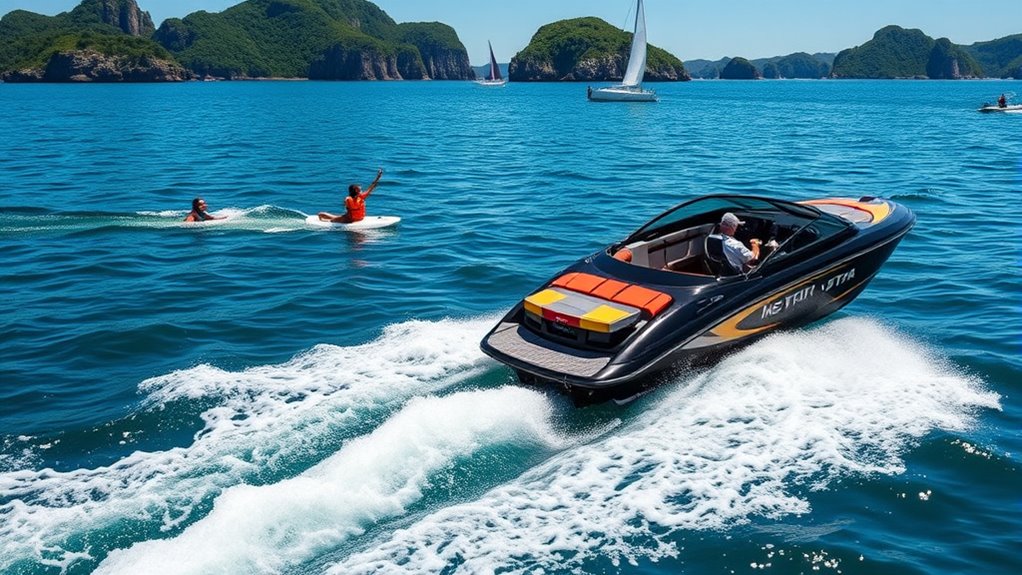
Staying alert to your surroundings and other watercraft is essential for safe jet boating. Always keep a close watch for boats, kayaks, swimmers, and floating debris. Use your mirrors frequently to stay aware of nearby vessels, especially when changing course or speed. Pay attention to water conditions, such as currents and rocks, that could affect your boat’s control. Maintain a safe distance from other boats to prevent collisions, and be prepared to adjust your path if someone else is behaving unpredictably. Keep an eye out for shoreline activity and potential hazards like submerged logs or shallow areas. Staying vigilant helps you react quickly to unexpected situations, ensuring a safer and more enjoyable experience on the water.
Use Safety Equipment and Emergency Gear
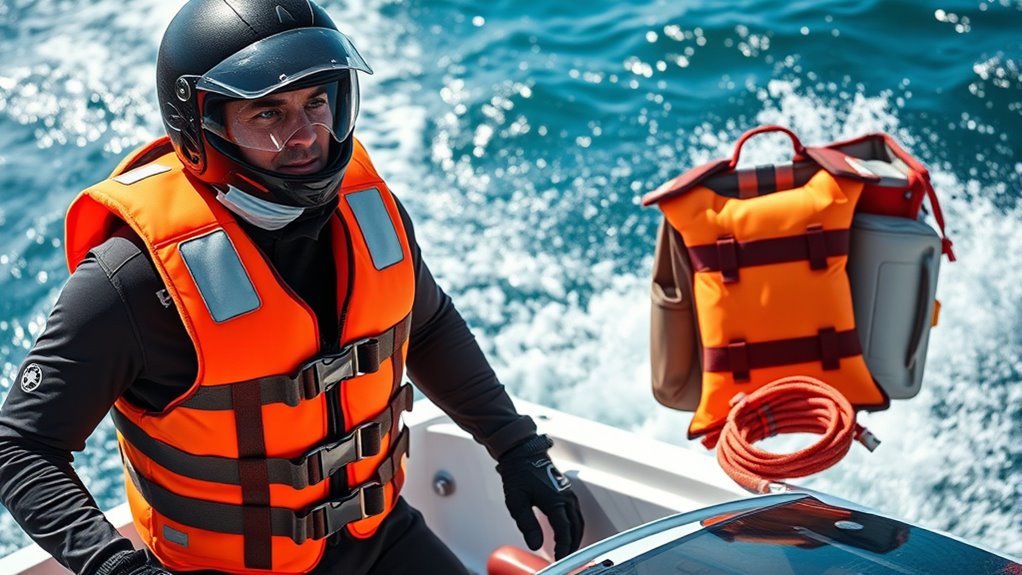
Always wear your life jacket whenever you’re on the water to stay safe in any situation. Make sure you carry emergency supplies like a whistle, flashlight, and a first aid kit in case of an unexpected event. Being prepared with the right gear can make all the difference if something goes wrong. Additionally, understanding skin exfoliation benefits can help you recognize the importance of skin health, which is essential for overall well-being during outdoor activities.
Wear Life Jackets
Wearing a life jacket is one of the most crucial safety measures you can take when riding a jet boat. A properly fitted life jacket keeps you afloat if you fall into the water unexpectedly. Always choose a jacket rated for your weight and size, and verify it’s Coast Guard-approved. Before starting your ride, put it on securely, adjusting the straps for a snug fit. Even if you’re a strong swimmer, accidents happen quickly, and cold water or rough conditions can impair your ability to stay afloat. Don’t take shortcuts by wearing an ill-fitting or outdated life jacket. Remember, your safety depends on being prepared. Wearing a life jacket isn’t just a recommendation; it’s an essential step to protect yourself and enjoy your ride responsibly. Recognizing recurring safety signs, such as the importance of safety equipment, can further enhance your preparedness and ensure a safe experience.
Carry Emergency Supplies
Packing emergency supplies and safety gear can make all the difference if an unexpected situation arises during your jet boat ride. Always bring a waterproof bag with essentials like a first aid kit, flashlight, and extra batteries. Include a whistle or signaling device to attract attention if needed. Carry a fully charged mobile phone in a dry case for quick communication. Consider packing a small tool kit or multi-tool for minor repairs. Water and high-energy snacks are crucial in case you’re stranded longer than expected. Having these supplies on hand ensures you’re prepared for emergencies and can help you stay calm and prioritize safety. Being equipped with the right gear can turn a potentially dangerous situation into a manageable one, giving you peace of mind on your adventure. Additionally, understanding relationship dynamics can help you stay calm and communicate effectively in stressful situations. Familiarizing yourself with pinball mechanics can also be useful if you’re interested in troubleshooting or maintaining your equipment after an incident. Furthermore, knowing love and relationships can foster a supportive environment among your group, making it easier to handle unforeseen circumstances with cooperation and understanding. Developing industry trends awareness can also help you adapt quickly to new safety protocols or equipment updates. Staying informed about psychological assessment tools can further enhance your preparedness by recognizing and managing stress responses during emergencies.
Take a Safety Course or Receive Proper Training

Taking a safety course or receiving proper training is essential before you hit the water on a jet boat. It equips you with crucial skills to handle emergencies and operate the boat confidently. With proper training, you’ll understand how to navigate safely, recognize hazards, and respond effectively in critical situations. Additionally, understanding the best safety practices can significantly reduce the risk of accidents while enjoying your ride.
Frequently Asked Questions
What Should I Do if I Fall Into the Water Unexpectedly?
If you unexpectedly fall into the water, stay calm and try to conserve your energy. Immediately signal for help if others are nearby, and focus on floating or treading water to keep your head above the surface. Use your arms to steady yourself and look for a safe way to climb back into the boat or reach the shore. Remember, staying calm is key to avoiding panic and staying safe.
How Do I Handle a Jet Boat Emergency at High Speed?
When facing a jet boat emergency at high speed, stay calm and keep a firm grip on the boat. Immediately signal for help if needed, and if you can, steer the boat toward the shoreline or a safe area. Use your throttle to slow down gradually, avoiding sudden moves. Communicate clearly with others onboard, and prepare to follow emergency procedures to make certain everyone’s safety.
Are There Specific Safety Regulations for Jet Boat Riding?
Did you know that nearly 60% of jet boat accidents involve rider error or lack of adherence to safety regulations? When you ride, you should follow specific safety regulations set by local authorities or the boating organization. Always wear a life jacket, stay within designated areas, and listen to safety briefings. These rules are designed to keep you safe and ensure fun on the water, so follow them carefully.
Can I Ride a Jet Boat Alone Safely?
You can ride a jet boat alone, but it’s important to prioritize safety. Make sure you’re experienced and comfortable with the boat’s controls. Always wear a life jacket, follow the operator’s instructions, and stay alert to your surroundings. Check weather conditions before heading out, and let someone know your plans. Riding solo can be enjoyable, but taking precautions guarantees you stay safe while having fun.
What Are Common Signs of Mechanical Issues During Operation?
Ever wonder if your jet boat’s throwing a tantrum? Common signs of mechanical issues include strange engine noises, unusual vibrations, or sudden power loss. If you notice warning lights flickering or the boat struggling to accelerate, don’t ignore them—they’re like the boat’s way of shouting for help. Regular checks and attentive riding can prevent minor hiccups from turning into major disasters, keeping your adventure smooth and safe.
Conclusion
By following these safety tips, you can enjoy your jet boat rides with confidence and peace of mind. Did you know that wearing a life jacket reduces the risk of drowning by 50%? Staying alert, prepared, and informed makes all the difference. So, always prioritize safety, stay cautious, and have fun exploring the water responsibly. Remember, a safe ride is a memorable ride—so gear up and make every trip enjoyable!



